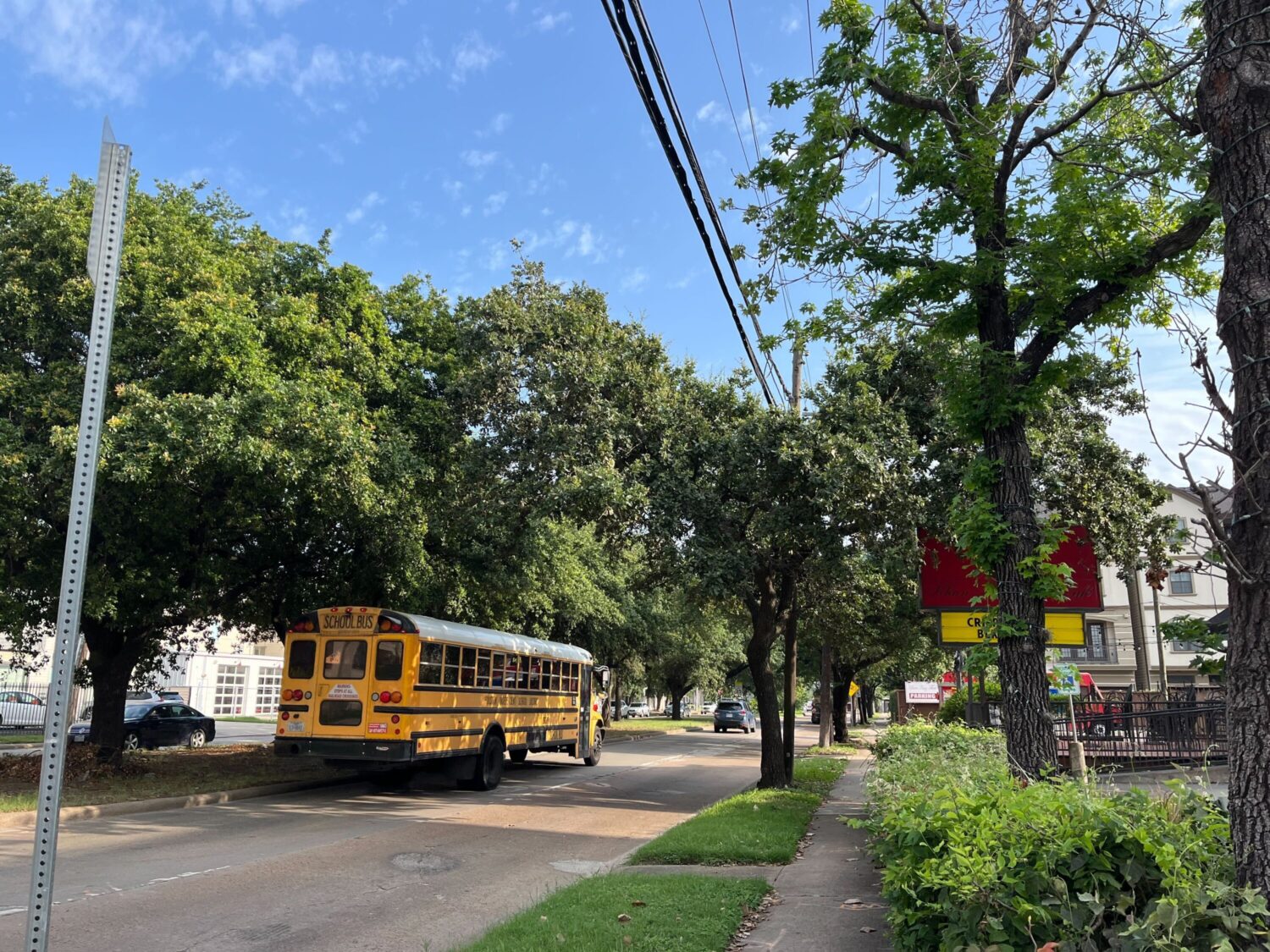Colleen DeGuzman
Ava Rais loves to cartwheel her way to school.
Ava is a first grader at Wharton Dual Language Academy in Montrose and, when weather permits, she walks to school with her dad Mehdi Rais and older sister Lyla Rais who is in third grade. They often pick up Lyla’s friend and classmate Rian Watson on the way.
It’s a short 10-minute walk from the Rais’ home, and the kids use the time to catch up and get energy out before the school day begins. Ava asked her dad to hold her pink backpack because she wanted to get some cartwheels in, and in her brown cowboy boots, she flipped nearly a dozen times along Clay Avenue.
But once the crew got to Montrose Boulevard, a major thoroughfare in the neighborhood, the kids stopped and waited for Mehdi to make sure it was safe to cross.
Ahead of them was a four-lane intersection with a wide pedestrian walkway — but no stop lights or stop signs. The kids stayed close to their parents as they cautiously crossed the busy street, waving their hands at drivers to make sure they saw them. Two cars going well over school zone speed limits had to brake quickly. Mehdi said that happens all too often.
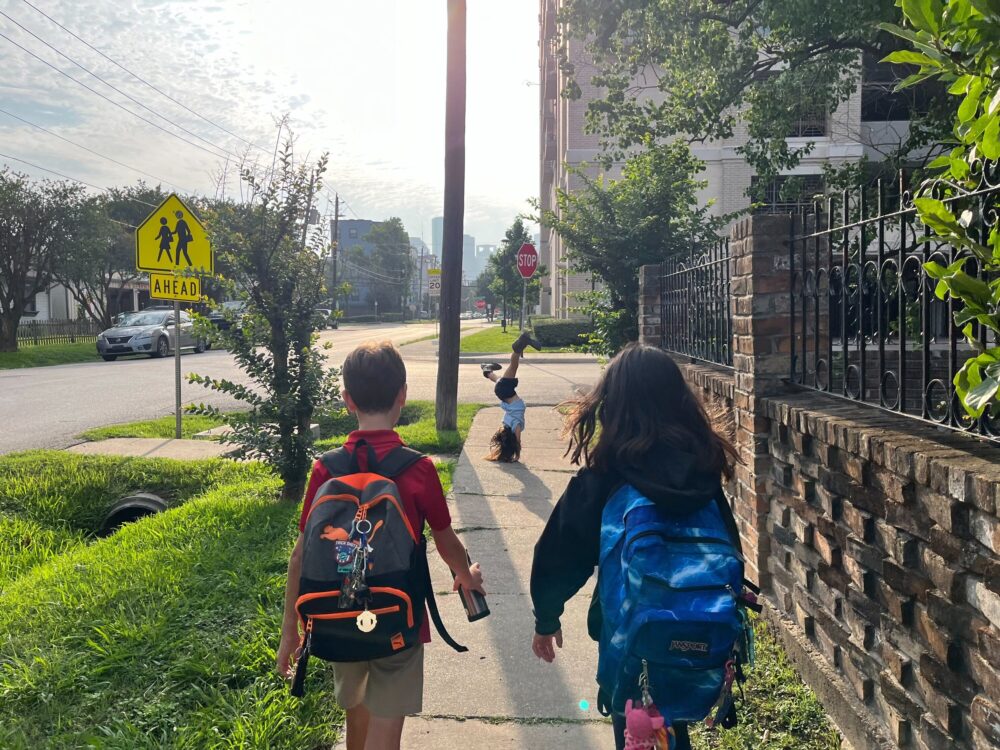
Colleen DeGuzman
An ambitious redevelopment plan along Montrose Boulevard, years in the making, aims to improve the area’s walkability, drainage system, and traffic safety. Tax Increment Reinvestment Zone 27 is heading the Montrose Boulevard Improvement Project and has crafted major plans for the neighborhood.
Some improvements include replacing its 80-year-old drainage infrastructure (one of the oldest in Houston’s inner loop), paving new sidewalks on both sides of a mile-long stretch, and installing more pedestrian-controlled crosswalks. Many parents in the neighborhood said the latter is much needed.
Ava recalled that one morning, “We were walking to school on Montrose and one car almost runned over us.” Rian giggled, adding that the driver “dropped the F-word.”
The project should have been under construction by now, but Mayor John Whitmire stopped it in late February after his administration took over. TIRZ 27 was close to breaking ground, but Whitmire paused it for his office to review.
“It’s very disputable that Montrose and its high elevation relative to Houston is a major drainage concern,” Whitmire said in an interview with Houston Matters. The mayor has temporarily paused multiple mobility projects across the city, which was approved by his predecessor, former Mayor Sylvester Turner.
The proposed project is divided into two portions: Segment 1, going from Allen Parkway to W. Clay Street, and Segment 2, the stretch from W. Clay Street to US-59. So far, TIRZ 27 has only completed plans and secured funding for Segment 1, which is estimated to cost $14.7 million. The cost for Segment 2 is estimated to be around $47 million but its plans are far from being finalized.
Whitmire has expressed concerns over the project’s plans to shorten the width of the boulevard’s car lanes. Some say that could make drivers more prone to accidents, while others argue it would push them to slow down and drive safer.
“We’re not going to lose federal funding by a redesign. If we do, that’s the cost of doing it right,” Whitmire said.
A recently established group, Save the Montrose Live Oaks, applauds the mayor’s decision to pause the project, although they have different motives. The group organized once it was made clear that as many as 54 trees would be removed in Segment 1.
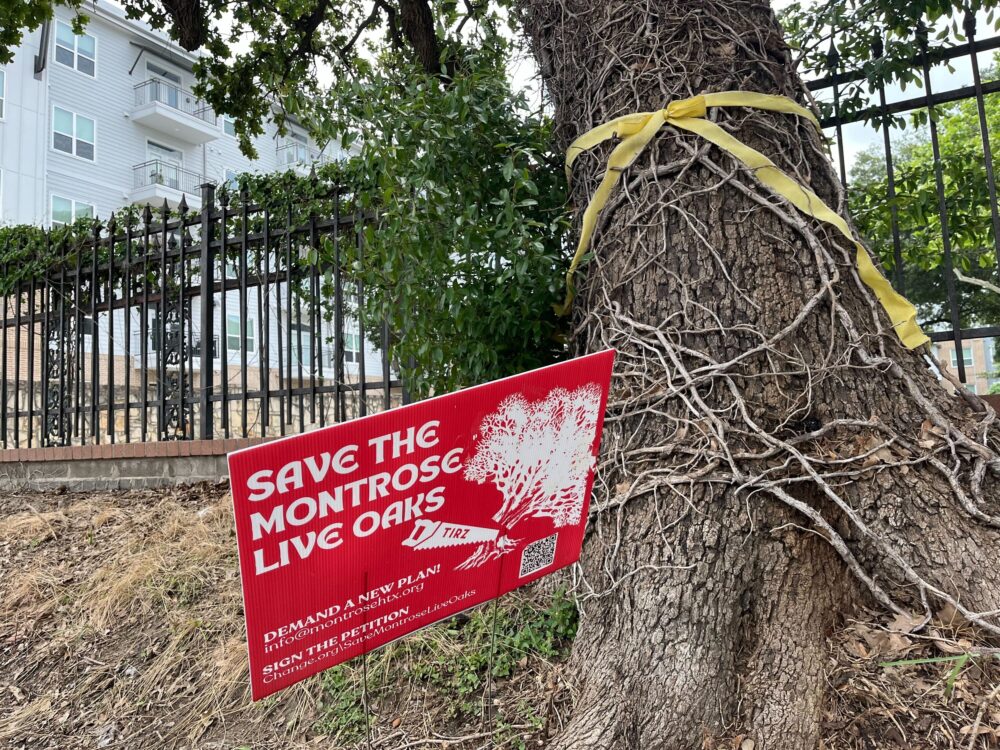
Colleen DeGuzman
“We want good sidewalks, we want good streets, we want good drainage,” the organization’s founder, Jonna Hitchcock said at an open house this month, adding that they could make those improvements without having to sacrifice trees. Although TIRZ 27 plans to plant 154 new trees which they say would be placed in areas with more space to grow, people with Save the Montrose Live Oaks are staying loyal to the existing tree canopy.
TIRZ 27 President Joe Webb calls Montrose Boulevard “the drainage spine for the neighborhood” and said the project was initially one focused on drainage following a 2019 drainage study on the area. Webb said if the neighborhood wants to improve its infrastructure “no matter what we do, if we do anything, we take out trees.” He said many of the trees being removed aren’t positioned to grow well anyways, “so we figured ‘OK, if that’s the case, let’s go back and do it right.'”
Webb has been a Montrose resident for nearly three decades and speaks passionately about his visions for the neighborhood.
“If we can make it as walkable and everything as we want, it’s going to get denser, more people, which means more employment, it means more tax base,” Webb said from the porch of Canary Coffee House, a cafe in Montrose. “It’s lots of economic benefits in addition to improving the environment because less driving means more walking. Works to your advantage. Lots of positive change in my book.”
He said he understands the mayor’s reticence, however. “He’s got to listen to all parties, but my hope is that he’ll work with us. I think he will, I don’t see a reason why he wouldn’t.”
Segment 1 would take about a year to complete, and Mehdi, a father of two young daughters, said it’s an investment the neighborhood needs to make for the future.
“We’re not doing this just for today, we are doing this for the next 80 years,” said Mehdi, who has been a strong advocate of the project for years. “We have a duty and a responsibility to leave the place slightly better than what we inherited.”
Who Speaks for the Trees?
Save the Montrose Live Oaks has worked hard in the last few months to make its voices heard and opinions known. They’ve placed posters all along the boulevard about their opposition to the project and have collected over 8,000 signatures for a petition to preserve the neighborhood’s live oaks. However, it’s not clear that those signatures are from people who live in Montrose or even in Texas.
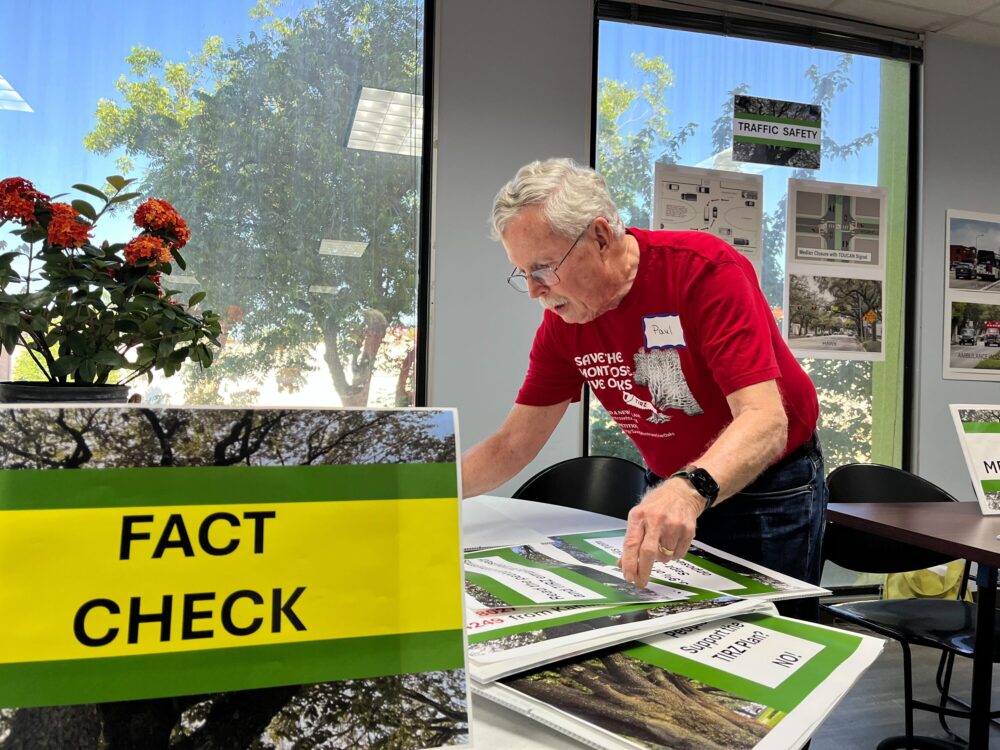
Colleen DeGuzman
At the center of the organization’s argument are three massive and lush post oaks in front of the Magnolia Cemetary’s gates estimated to be around 160 years old. They’re endearingly known as the Three Sister Trees of Montrose and were recognized as historic landmarks earlier this year.
People with Save the Montrose Live Oaks have rallied around the sister trees to pressure TIRZ from putting a sidewalk beside the cemetery which would uproot the post oaks. Although the plans in that area aren’t finalized yet, TIRZ 27 said it’s likely that the trees won’t be touched.
But TIRZ 27’s contracted urban forester, Craig Koehl pointed out that the northmost tree is “infested with a fungus at the base that’s eating away at the base of the trunk.” Although its branches and leaves are bushy and green, its base is rotting and its heavy top may cause it to fall someday soon, Koehl said. When he knocks on the base of the tree, it sounds hollow because of a cavity at its lower trunk.
Koehl said he has evaluated every single tree along the mile stretch of the boulevard and said he considers two factors: the structural integrity of the tree and its long-term survival. Koehl said no tree planted longer than three decades ago will be removed and that many of the trees they plan to take out are planted in plots that are too small for them, stunting their growth. Many trees scheduled to be removed are also directly under power lines, subjecting them to shavings by electricians.
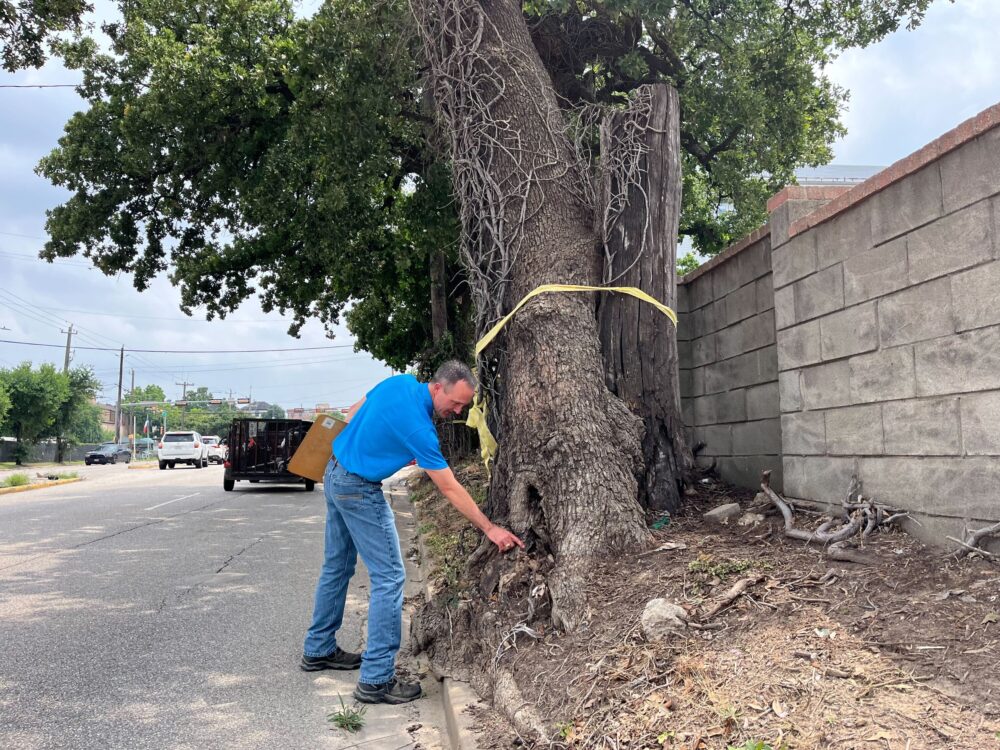
Colleen DeGuzman
Matt Latham, an arborist who consults for Save the Montrose Live Oaks, disagreed and claims the trees are thriving as they are.
“Trees are adaptive in nature, the roots only grow in an area where there’s water and oxygen,” Latham said, adding that “when they get to an area that’s not beneficial, like say, in the middle of the street, they’re going to turn around and find where the areas that are beneficial are.”
Nearly three will be planted for every tree removed, but Sarah Fraizer, a Save the Montrose Live Oaks member, worries that the neighborhood would lose its beloved tree canopy – one of Montrose’s well-known charms.
“There is no reason why you cannot reconstruct a street and keep the trees,” said Fraizer. She added that although TIRZ 27 plans to plant more trees than they’re removing, “I won’t be able to enjoy them in my lifetime. I’m over 50 and by the time we have a canopy back, I’ll be at the end of my lifetime.”
But Webb said that the trees they plan to plant “will provide shade from day one” since they’ll be at least 14 feet tall and 8 feet wide. “And once they really start growing, oh it will make a huge difference.”
Additionally, none of the mature oak trees in the street’s median will be taken out.
Koehl, TIRZ 27’s urban forester, said many of the trees along the west and east sides of the boulevard, which don’t account for the tree canopy, aren’t in a position to thrive and live as long as they should.
“If we only preserve the oldest and declining and dying trees, what are we leaving the next generation?” he said. “We have to identify those trees that are at the end of their useful life and acknowledge that they’re at the end of their useful life.”
Walkability and Drainage
Conflicts among the project’s supporters and those with Save the Montrose Live Oaks have branched out into other components of the project. Is there even a drainage problem in Montrose? Is Montrose considered a walkable area, would people even use a shared path along the boulevard?
Fraizer, a staunch opposer of the project, lives in Montrose and said she has lived through many of Houston’s recent hurricanes and floods and hasn’t had a drainage issue yet.
“I’ve never come close to having water in my house,” she said.
Fraizer said Montrose isn’t dealing with the flooding problems the rest of the city has because it’s more elevated than the rest of the city. When it rains, all the neighborhood experiences is ponding.
“There was some ponding yesterday, and then it was gone,” she said, referring to a storm Houston had in late April. “So, you know, when people talk about flooding dangers in Houston, that’s not what they’re talking about.”
Others say flooding is a major problem in the neighborhood. Canary Coffee House is along the boulevard, and owner Joey Paffel said, “Even with the smallest amount of rain, part of the road will fill up, and at least half of the traffic lane will be filled with water.”
During a short rainstorm earlier this month, Webb, who chairs TIRZ 27, was at Canary and while looking out of the shop’s large windows, he was stunned by how quickly the boulevard flooded.
“We haven’t had but 15 minutes of rain and the curb lane is already filling up,” he said. “So, drainage is an issue.”
Paffel added that the street’s sidewalks are in dire need of repair. Many of his customers are Montrose residents who either walk or bike to grab coffee, but the sidewalks are so broken and so close to the street that it’s difficult for them to do so safely—especially customers in wheelchairs.
He said having construction beside the coffee shop would be difficult, “but I think at the payoff at the end of that — to be able to have access to a patio and to be able to be connected to a walkable and bikeable corridor — will far outweigh the temporary pain of a traffic jam from construction.”
Frazier, however, argues that making Montrose more walkable is trying to mold it into something it’s not.
“Shepard and Montrose are two of the very few arteries that go north-south in this area and cars are going to keep using them,” she said. “And so they’re actually never going to be the places where we do most of our walking and running.”
Stephen Longmire is a long-time resident of Montrose and a strong supporter of the improvement project. He moved into the neighborhood in the 1970s and has a deep love for its unique charm, but he worries about the infrastructure that might be left for the next generation.
“The concrete you see on the street right outside this restaurant is the same concrete that I drove on when I first got here in 1978,” Longmire said. “Exactly the same, not a single change, except for more and more and more patches and more cuts and little patches.”
Longmire said the mayor’s decision to pause the project has caused him to lose trust in his leadership.
“That’s not how you run a city, it’s just not,” he said. “And I voted for this mayor, I had great hopes for him. I have become afraid of him now. I think that he’s going to do great harm to this city and that we’ve got at least four years of a hard fight.”

